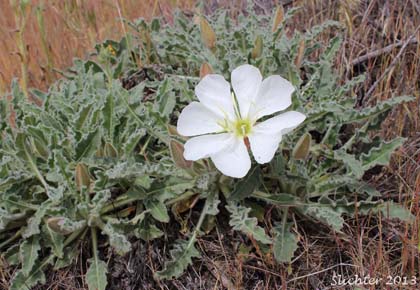|
|
Primrose, Pale Evening - Oenathera pallida |
Primrose, Evening Tufted - Oenothera caespitosa subsp. marginata |
Description
Primrose, Pale Evening - Oenathera pallida
"Duration: Perennial Nativity: Native Lifeform: Forb/Herb General: Perennial herb, 10-50 cm tall, from a taproot and rhizome-like lateral roots; stems solitary or several from the base, the central stem erect and the others ascending; stems simple or branching throughout; stem epidermis white, exfoliating; herbage glabrous or covered with soft canescent or stiff hairs. Leaves: Alternate along the stems, and also in a basal cluster which occasionally persists until flowering; blades narrowly lanceolate to ovate, 2-4 cm long, the margins deeply runcinate-pinnatifid to sinuate-dentate or entire to serrate. Flowers: White and showy; sessile in the axils of upper leaves; hypanthium (floral tube at the base of the flower) slender and cylindric, 15-35 mm long; sepals 4 per flower, 12-18 mm long, pointed downward (reflexed) in full flower; petals 4, broadly obovate, 10-20 mm long, white when fresh and aging pink; flowers open near sunset. Fruits: Capsule cylindric, straight to curved or contorted, and tapering toward the apex, 15-60 mm long and 15-25 mm wide; splitting open longitudinally along 4 suture lines to release many seeds, these about 2 mm long. Ecology: Found on sandy soils to dry flats and slopes, from 3,500-8,000 ft (1067-2438 m); flowers May-September. Notes: Oenothera albicaulis appears similar with its white stems and similar growth form, but that species lacks the exfoliating epidermis on the stems that Oe. pallida has; also, Oe. albicaulis is an annual and lacks the rhizome-like lateral roots that this species has. There are three subspecies are worth noting in our region. Subsp. pallida is nearly hairless; has leaves with fine teeth along the edges; and a usually contorted seed pod. Subsp. runcinata is sparsely to densely strigillose (with short, sharp appressed hairs) on the upper stems and leaves, or else mostly glabrous; is much-branched above the base and stoutly perennial, even becoming a subshrub; and usually has a straight or curved seed pod. Subsp. trichocalyx is conspicuously villous (covered with long soft hairs) on the upper stems and leaves; usually has a contorted capsule; and has few branches above the base, being a shorter-lived perennial or even annual. Ethnobotany: Used as a ceremonial emetic, for venereal disease, sores, spider bites, kidney disease, snake bites, sore throat, and in other ceremonial ways. Etymology: Oenothera comes from the Greek oinos, wine, and therao, to seek or imbibe, alluding to the fact that the root of Oenothera biennis was used to flavor wine; pallida means pale, in reference to the often pale leaves. Synonyms: None Editor: SBuckley 2010, AHazelton 2017" (SEINet)
Description
Primrose, Evening Tufted - Oenothera caespitosa subsp. marginata
"This is a very common, wide ranging, Evening Primrose with a number of common varieties. It has very large white flowers, spreads by underground roots, and is often abundant in large colonies on steep dry slopes and sandy soils. The entire plant is quite low to the ground, and the flower, disproportionately large for the size of the rest of the plant, often touches the ground. Leaf length and depth of serrations and teeth varies. Flowers often open in the evening and wither to pink with the sun and heat of the next afternoon." (swcoloradowildflowers.com)
Medical:
"Navajo, Kayenta Ceremonial Medicine Plant used as a Beadway emetic. Dermatological Aid Plant used as a dusting powder for venereal disease sores. Poultice of plant applied to spider bites. --- Kidney Aid Infusion of plant used for kidney disease." (Moerman 362)
